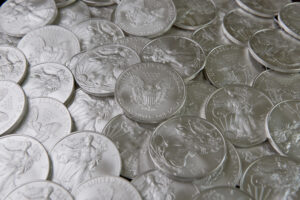
Industrial Demand Might Consume The Entire Silver Market by 2025
The comments below are an edited and abridged synopsis of an article by PR
Recent projections suggest a worrying scenario for the silver market: Inventories could run out by 2025 due to skyrocketing industrial demand. This anticipated shortage is causing concern among industries, investors, and market analysts, as silver is integral to a wide range of applications. From electronics and renewable energy to electric vehicles and military technology, the demand for silver is expected to escalate, leading to potential supply challenges and market volatility.
Rising Industrial Demand
Silver’s unique properties, such as its exceptional conductivity and reflectivity, make it indispensable across several high-tech industries. The electronics sector, photovoltaics, and the automotive industry are particularly reliant on silver.
1. Technological Advancements: Silver is an essential component in various cutting-edge technologies. Industries like electronics and photovoltaics (solar panels) heavily depend on silver for its superior conductive and reflective qualities. This reliance is expected to grow as technology continues to advance.
2. Solar Power Surge: The solar energy sector has been a significant driver of silver demand, and this trend shows no signs of slowing down. Photovoltaic (PV) installations, which are predicted to reach 660 GW globally by 2024, require substantial amounts of silver, thereby exerting immense pressure on existing supplies.
3. Electric Vehicles (EVs): The push towards electric vehicles is another critical factor fueling silver demand. Silver plays a vital role in EVs, particularly in battery systems and electronic components. As the market for electric vehicles expands, so does the demand for silver.
Military Use as a Key Factor
Silver’s importance extends beyond commercial applications. The military sector also significantly contributes to silver consumption, owing to its strategic use in advanced defense technologies.
1. Defense Technology: Silver’s superior electrical conductivity and corrosion resistance make it invaluable for defense systems, weaponry, communication devices, and surveillance equipment. As a result, the military’s reliance on silver is expected to continue growing.
2. Aerospace Applications: In aerospace, silver is used extensively for its reliability and efficiency in critical components. With global defense budgets on the rise, the military and aerospace sectors are likely to consume even more silver in the coming years.
Declining Mining Output and Exploration Challenges
The supply side of silver is facing significant hurdles, which exacerbate the looming shortage.
1. Mining Challenges: Silver mines are producing less, with existing reserves dwindling and fewer significant discoveries being made. This decline in mining productivity poses a serious threat to maintaining current inventory levels.
2. Exploration Difficulties: Discovering new silver deposits has become increasingly difficult and costly. As high-quality ores become scarcer, mining companies are struggling to sustain production levels, further contributing to the potential inventory crisis.
Market Implications
The anticipated depletion of silver inventories is likely to have far-reaching implications for markets and investors.
1. Price Volatility: As industrial demand depletes silver inventories, analysts predict increased price volatility. The scarcity of silver could result in sharp price hikes, impacting everything from jewelry to electronics.
2. Investment Opportunities: Investors are keenly observing these developments, recognizing both risks and opportunities. While some may benefit from potential price surges, others may face challenges due to increased market unpredictability.
3. Supply Chain Strain: Industries heavily reliant on silver are preparing for possible supply chain disruptions. Many companies are exploring alternative materials and investing in recycling technologies to mitigate the impact of silver shortages.
Expert Insights
Experts are raising alarms about the future of silver inventories, emphasizing the urgent need for innovative solutions and sustainable practices.
– Johannes Bernreuter, Head of Bernreuter Research, highlights the unprecedented demand for silver driven by technological advancements and the global push for renewable energy. He warns that if current trends persist, significant inventory shortfalls could occur by 2025.
– Michael DiRienzo, Executive Director of the Silver Institute, echoes these concerns, noting the relentless rise in industrial demand for silver. He stresses the importance of addressing the impending supply crunch through strategic foresight and innovation.
As the clock ticks towards 2025, the global market braces for the profound impact of industrial and military silver demand on inventories. Stakeholders across sectors must navigate this evolving landscape with strategic foresight and innovation to mitigate the looming supply crunch. In conclusion, the potential depletion of silver inventories by 2025 is a pressing concern that requires immediate attention from industries and investors alike. As demand continues to rise, the silver market must adapt to ensure sustainable supply and mitigate the impact of potential shortages on the global economy.



